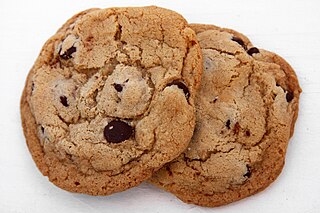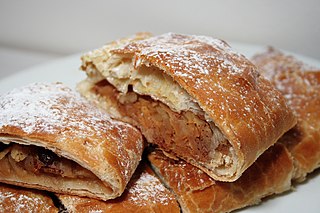
A cookie is a baked or cooked snack or dessert that is typically small, flat and sweet. It usually contains flour, sugar, egg, and some type of oil, fat, or butter. It may include other ingredients such as raisins, oats, chocolate chips, nuts, etc.

Bread is a staple food prepared from a dough of flour and water, usually by baking. Throughout recorded history and around the world, it has been an important part of many cultures' diet. It is one of the oldest human-made foods, having been of significance since the dawn of agriculture, and plays an essential role in both religious rituals and secular culture.

Pastry is baked food made with a dough of flour, water and shortening that may be savoury or sweetened. Sweetened pastries are often described as bakers' confectionery. The word "pastries" suggests many kinds of baked products made from ingredients such as flour, sugar, milk, butter, shortening, baking powder, and eggs. Small tarts and other sweet baked products are called pastries as a synecdoche. Common pastry dishes include pies, tarts, quiches, croissants, and pasties.

A doughnut or donut is a type of food made from leavened fried dough. It is popular in many countries and is prepared in various forms as a sweet snack that can be homemade or purchased in bakeries, supermarkets, food stalls, and franchised specialty vendors. Doughnut is the traditional spelling, while donut is the simplified version; the terms are used interchangeably.

A croissant is a buttery, flaky, Austrian viennoiserie pastry inspired by the shape of the Austrian kipferl but using the French yeast-leavened laminated dough. Croissants are named for their historical crescent shape, the dough is layered with butter, rolled and folded several times in succession, then rolled into a thin sheet, in a technique called laminating. The process results in a layered, flaky texture, similar to a puff pastry.

Pigs in a blanket is a small hot dog or other sausage wrapped in pastry commonly served as an appetizer in the United States. The similarity in name with that of the UK dish pigs in blankets, which is a sausage wrapped in bacon, sometimes causes confusion.

Chapati, also known as roti, rotli, safati, shabaati, phulka, chapo, poli, and roshi, is an unleavened flatbread originating from the Indian subcontinent and staple in India, Nepal, Bangladesh, Pakistan, Sri Lanka, East Africa, Arabian Peninsula and the Caribbean. Chapatis are made of whole-wheat flour known as atta, mixed into dough with water, oil (optional), salt (optional) in a mixing utensil called a parat, and are cooked on a tava.

Beignet is a type of fritter, or deep-fried pastry, usually made from yeast dough in France, possibly made from pâte à choux and called Pets-de-nonne, nun's fart, in France, but may also be made from other types of dough, including yeast dough. In France there are many different versions of them, at least 20. They can vary in shape, the flour used for the dough, and the filling. It is popular in French, Italian, and French-American cuisines.

Dough is a thick, malleable, sometimes elastic paste made from grains or from leguminous or chestnut crops. Dough is typically made by mixing flour with a small amount of water or other liquid and sometimes includes yeast or other leavening agents, as well as ingredients such as fats or flavorings.

A churro is a type of fried dough from Spanish and Portuguese cuisine. They are also found in Latin American cuisine and in other areas that have received immigration from Spanish and Portuguese-speaking countries, especially in the Southwestern United States and France.

Spätzle is a type of pasta or dumpling made with eggs, typically serving as a side for meat dishes with gravy. Commonly associated with Swabia, it is also found in the cuisines of southern Germany and Austria, Switzerland, Hungary, Vojvodina, Slovenia, Alsace, Moselle and South Tyrol.

Fried dough is a North American food associated with outdoor food stands in carnivals, amusement parks, fairs, rodeos, and seaside resorts. "Fried dough" is the specific name for a particular variety of fried bread made of a yeast dough; see the accompanying images for an example of use on carnival-booth signs. Fried dough is also known as fry dough, fry bread (bannock), fried bread, doughboys, elephant ears, beaver tails, scones, pizza fritte, frying saucers, and buñuelos. These foods are virtually identical to each other and some yeast dough versions of beignets, and recognizably different from other fried dough foods such as doughnuts or fritters.

Apple strudel is a traditional Viennese strudel, a popular pastry in Austria, Bavaria, the Czech Republic, Northern Italy, Slovenia, and other countries in Europe that once belonged to the Austro-Hungarian Empire (1867–1918).

Filo or phyllo is a very thin unleavened dough used for making pastries such as baklava and börek in Middle Eastern and Balkan cuisines. Filo-based pastries are made by layering many sheets of filo brushed with oil or butter; the pastry is then baked.

A hamantash is an Ashkenazi Jewish triangular filled-pocket pastry, associated with the Jewish holiday of Purim. The name refers to Haman, the villain in the Purim story. In Hebrew, hamantashen are also known as אוזני המן meaning "Haman's ears". "Haman's ears" also refers to a Sephardic Purim pastry, "Orejas de Haman", thought to originate in Spain and Italy, that is made by frying twisted or rolled strips of dough.

Sufganiyah is a round jelly doughnut eaten in Israel and around the world on the Jewish festival of Hanukkah. The doughnut is deep-fried, injected with jam or custard, and then topped with powdered sugar. The doughnut recipe originated in Europe in the 16th century, and by the 19th century was known as a Berliner in Germany. Polish Jews, who called it a ponchik, fried the doughnut in schmaltz rather than lard due to kashrut laws. The ponchik was brought to Israel by Polish Jewish immigrants, where it was renamed the sufganiyah based on the Talmud's description of a "spongy dough".

In cooking, kneading is a process in the making of bread or dough, used to mix the ingredients and add strength to the final product. Its importance lies in the mixing of flour with water; when these two ingredients are combined and kneaded, the gliadin and glutenin proteins in the flour expand and form strands of gluten, which gives bread its texture. The kneading process warms and stretches these gluten strands, eventually creating a springy and elastic dough. If bread dough is not kneaded enough, it will not be able to hold the tiny pockets of gas created by the leavening agent, and will collapse, leaving a heavy and dense loaf.

Dumpling is a broad class of dishes that consist of pieces of dough, oftentimes wrapped around a filling. The dough can be based on bread, flour, buckwheat or potatoes, and may be filled with meat, fish, tofu, cheese, vegetables, fruits or sweets. Dumplings may be prepared using a variety of methods, including baking, boiling, frying, simmering or steaming and are found in many world cuisines. In the United States in May 2015 National Day Calendar listed National Dumpling Day as held on September 26, annually.

Paratha is a flatbread native to South Asia, prevalent throughout the modern-day nations of India, Sri Lanka, Pakistan, Nepal, Bangladesh, Maldives, Afghanistan, Myanmar, Malaysia, Singapore, Mauritius, Fiji, Guyana, Suriname, and Trinidad and Tobago where wheat is the traditional staple. Paratha is an amalgamation of the words parat and atta, which literally means layers of cooked dough. Alternative spellings and names include parantha, parauntha, prontha, parontay, paronthi (Punjabi), porota, paratha, palata, porotha, forota, farata, roti canai, prata, paratha, buss-up shut, oil roti.


















